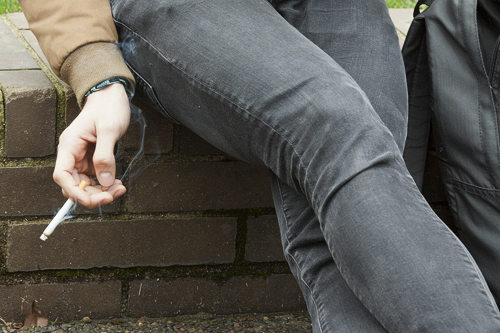For nonsmoking students on campus, secondhand smoke can be a serious annoyance, if not a major health issue. Even with the implementation of the Clean Air Corridor, there are plenty of other places on campus where students could be inhaling others’ smoke.
Smoke-free challenge introduced at PSU

For nonsmoking students on campus, secondhand smoke can be a serious annoyance, if not a major health issue. Even with the implementation of the Clean Air Corridor, there are plenty of other places on campus where students could be inhaling others’ smoke.
Today, federal, state and local officials will launch a Fresh Air Campus Challenge at Portland State. They will encourage a policy to make all college campuses in Alaska, Idaho, Washington and Oregon completely smoke- and tobacco-free by 2016.
“If successful, this challenge has the potential to protect students, staff and faculty from involuntary exposure to secondhand smoke, while encouraging a social norm change that will reduce tobacco use,” PSU Vice President Jackie Balzer and Dr. Howard Koh, assistant secretary for health at the U.S. Department of Health and Human Services wrote in an article submitted to the Vanguard.
The announcement will be made officially at 10 a.m. in the Native American Student and Community Center at 710 SW Jackson St.
Koh and Dr. Mel Kohn, state health officer and director of the Oregon Health Authority’s Public Health Division, will speak at the event, along with Balzer, U.S. Department of Health and Human Services Regional Administrator Dr. Patrick O’Carroll and a board of students.
Portland State has already taken steps toward becoming a tobacco-free campus.
“Through the adoption of the Clean Air Corridor and the recent ban on smoking in the Urban Plaza, Portland State University is building the momentum necessary to become a Fresh Air Campus,” Balzer and Koh wrote. “The PSU process will continue to unfold and will include campus discussions.”
The CAC covers the buildings along Southwest Broadway, including Smith Memorial Student Union.
Portland State will be the first campus to sign on to the challenge, according to the article.
One reason that state and national health officials want to focus on college campuses to promote public health is because while students are in college they are more likely to begin smoking or shift to regular smoke and tobacco use from experimentation.
“Most people who smoke start before the age of 26,” O’Carroll said. “Preventing the initiation of smoking in this age group is proven to work.”
According to Balzer and Koh, more than 20 percent of the 500,000 people who smoke in Oregon are between the ages of 18 and 24.
“The Surgeon General’s 2012 Report on Tobacco…notes that 90 percent of all smokers start before age 18, and 99 percent start before age 26,” Balzer and Koh wrote.
College students are at a much higher risk to begin smoking, which is why health officials deem the Regional Fresh Air Campus Challenge so important.
According to O’Carroll, smoking also remains the top most preventable cause of death in the nation.
It contributes to numerous other health risks as well.
“Research shows that regardless of age, those who stop smoking and using tobacco can substantially reduce their risk for disease,” Balzer and Koh wrote. “We encourage anyone who is interested in quitting to seek help with a smoking-cessation program, such as the Oregon Tobacco Quit Line, or through their health insurance plans.”
Health officials hope to educate students, faculty and staff about the risks of smoking in order to get them on board with the challenge.
“There will be a lot of education about the issues,” said Molly Reece, master of public health and a Communities Putting Prevention to Work Grant project officer at Public Health of Seattle and King County. “We want them to know why tobacco is an issue.”
One of the steps health officials are taking in order to eventually get to a tobacco-free campus is publicity.
“We want to get the word out,” O’Carroll said. “With a website where you can sign up for the challenge, you can access tools and policies…it will help create a network.”
O’Carroll also wanted to emphasize the teamwork involved in the challenge.
“Although we are leading at the federal level…this is a collaborative effort with the American Cancer Society, American Lung Association, American Heart Association, Americans for Nonsmokers Rights and the American College Health Association,” O’Carroll said.
According to health officials, more than 1,100 higher education systems and 60 college campuses in the Pacific Northwest have already taken the initiative to become smoke- and tobacco-free.
HHS put this policy in place to promote public health as well as protect their own employees across the nation.
“The movement has already begun,” O’Carroll said.
The end goal for health officials and PSU is to endorse the health of those in the PSU community.
“The most important thing we have in this life is our health,” Balzer and Koh wrote. “With the Fresh Air Challenge we can begin here…to improve the public health through tobacco-free and smoke-free environments.”






I am thrilled this article was published by the Vanguard as I was unsure how to voice my thoughts on the overall status of the program as a non-smoker (outsider?) looking in.
Although the Fresh Air Challenge is met with good intentions, I am reminded daily what a joke of a campaign this is as walk through campus, dodging cloud after cloud of loitering smoker within the “corridor”. Many typically smoking next to “No Smoking” signs. Whether it is cluelessness on their part or an F U to the system, I can never tell.
As I get closer to the building entrances, I witness smokers exiting (Cramer, Smith, etc.), with unlit cigarette already clutched eagerly in their mouth, ready for their fix. They pause slightly to blaze up only two steps out of the existing door, then continue walking, leaving a trail of smoke behind for all to enjoy as they saunter merrily away.
Here’s the problem: Enforcement. There is none. Without enforcement (ie: Ticketing those who violate smoking within a Clean Air Corridor) this is nothing more than lip service, cheery, colorful signage and window clings.
Portland is too polite to say anything to the offenders, so PSU enforcement should.
Are you listening Ms. Balzer!?!
It blows my mind that people can be so ignorant toward the fact that /maybe people have different goals than them./ Not everyone is a health nut that does every thing in their power to be as healthy as physically possible. There’s nothing wrong with that. This is legitimately nothing more than institutionalized bigotry.
Also the notion that second hand smoke /in open air environments/ poses a health risk is a joke.
“Not everyone is a health nut that does every thing in their power to be as healthy as physically possible. There’s nothing wrong with that.”
Except that when you inevitably must get treated for your tobacco-caused lung cancer (or mouth cancer, emphysema, heart disease, etc. etc. etc.) then the rest of us end up footing your bill.
I have no problem with folks choosing to be smokers; it’s just that they fail to realize they are freeloaders as well. Why should I be subsidizing your personal habits?
Aiden,
Smoking causes cancer, correct? Can we all agree on that? I mean, it says so on the side of the cigarette box, right?! Ok. Good. I’m glad we can at least come together on that fact.
Those who want to smoke should continue to do so, in their own designated area, away from those who do not. Why should you have to walk twenty steps out of your way for the majority of the population? Because, crazy enough, there are those of us walking around campus that would rather not inhale second hand lung penetrating carcinogens, for your fix, just to increase our own chances of emphysema, heart disease and cancer. If you want to smoke and invite everything else that comes with it into your body, I say go for it, I respect your right to do so but I don’t want anything to do with that lifestyle. Nor do I believe I should be subjected to it for your own convenience.
But then again, what do I know. I’m just some crazy health nut.